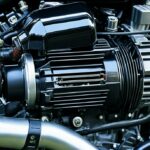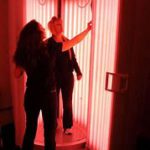Last Updated on 12 months by Francis
An alternating current (AC) generator is a device that converts mechanical energy into electrical energy by utilizing electromagnetic induction. One of the most important components of an AC generator is the electromagnetic field (EMF) that is generated within it. In this context, the question arises: How is EMF generated in an AC generator? In this essay, we will explore the principle behind EMF generation in AC generators and the factors that affect it.
Contents
Understanding EMF
EMF, or electromagnetic field, is a term used to describe the physical field that surrounds electrically charged objects. Electrically charged particles, such as electrons, create an electric field, while moving charged particles create a magnetic field. Together, these fields create an electromagnetic field.
AC Generators
AC generators, also known as alternators, are machines that convert mechanical energy into electrical energy. They work by rotating a coil of wire within a magnetic field, which creates an EMF that generates electrical energy. There are several components to an AC generator that contribute to the generation of EMF.
Stator
The stator is the stationary component of an AC generator. It consists of a series of coils or windings that are arranged in a circular pattern around the rotor. When an electric current flows through the coils, they create a magnetic field that interacts with the rotor to produce mechanical energy.
Rotor
The rotor is the rotating component of an AC generator. It consists of a shaft, which is connected to the turbine or engine that drives the generator, and a series of magnets or electromagnets that are arranged in a circular pattern around the shaft. When the rotor rotates, the magnets or electromagnets move past the stator coils, creating a changing magnetic field that induces an electrical current in the coils.
Slip Rings and Brushes
Slip rings and brushes are used to transfer the electrical current from the rotating rotor to the stationary stator. The slip rings are mounted on the rotor shaft and rotate with the rotor, while the brushes, which are typically made of carbon or graphite, are mounted on the stator and press against the slip rings. As the slip rings rotate, the brushes make contact with them, allowing the electrical current to flow from the rotor to the stator.
Frequency and Voltage
The frequency and voltage of the electrical energy generated by an AC generator depend on the speed of the rotor and the number of coils in the stator. The faster the rotor rotates, the higher the frequency and voltage of the electrical energy produced. Similarly, the more coils in the stator, the higher the frequency and voltage of the electrical energy produced.
Applications of AC Generators
AC generators are used in a wide range of applications, including power generation, transportation, and industrial processes. In power generation, AC generators are used to convert mechanical energy from turbines or engines into electrical energy that is distributed to homes, businesses, and industries. In transportation, AC generators are used in vehicles to provide electrical energy for lighting, heating, and other systems. In industrial processes, AC generators are used to power machinery and equipment that is used in manufacturing, construction, and other industries.
FAQs for the topic: how is emf generated in an AC generator
What is AC generator?
An AC generator is a device which converts mechanical energy into electrical energy. The electrical energy produced by an AC generator is in the form of Alternating Current (AC). AC generators are also referred to as alternators.
How is emf generated in an AC generator?
Emf or electromotive force is generated in an AC generator due to the rotation of a loop of wire placed in a magnetic field. When the loop of wire rotates in the magnetic field, it experiences a change in the magnetic flux. This change in the magnetic flux induces a voltage or emf across the ends of the loop. This process of generating emf using Faraday’s law of electromagnetic induction is the basis of AC generator operation.
What is Faraday’s Law of Induction?
Faraday’s Law of Induction states that when there is relative motion between a conductor and a magnetic field, an emf is induced in the conductor. The magnitude of the induced emf depends on the rate of change of magnetic flux through the conductor.
What is meant by magnetic flux?
Magnetic flux is a measure of the strength of the magnetic field passing through a given area. It is defined as the product of the magnetic field strength and the area through which it passes. The SI unit of magnetic flux is Weber (Wb).
How is the direction of emf determined in an AC generator?
The direction of the induced emf in an AC generator is determined by Lenz’s law, which states that the direction of the induced emf is such that it opposes the change in magnetic flux that produced it. This means that the induced emf creates a magnetic field that opposes the applied magnetic field.
What is the role of slip rings and brushes in an AC generator?
Slip rings and brushes are used to transfer the electrical energy produced in the loop of wire to an external circuit. The slip rings are circular conductors mounted on the shaft of the generator, and the brushes are stationary contacts that press against the slip rings to make electrical contact. The slip rings and brushes allow the electrical energy produced in the loop to be transferred to an external load without the need for physical wires.



.jpg)



